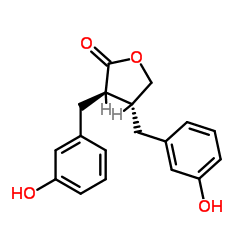Enterolactone
Modify Date: 2025-08-25 23:12:29

Enterolactone structure
|
Common Name | Enterolactone | ||
|---|---|---|---|---|
| CAS Number | 78473-71-9 | Molecular Weight | 298.33 | |
| Density | 1.3±0.1 g/cm3 | Boiling Point | 561.4±25.0 °C at 760 mmHg | |
| Molecular Formula | C18H18O4 | Melting Point | 141-143°C (lit.) | |
| MSDS | Chinese | Flash Point | 209.0±16.7 °C | |
| Symbol |

GHS07 |
Signal Word | Warning | |
Use of EnterolactoneEnterolactone is a bioactive phenolic metabolite known as a mammalian lignan derived from dietary lignans. Enterolactone has estrogenic properties and anti-breast cancer activity[1]. Enterolactone is a radiosensitizer for human breast cancer cell lines through impaired DNA repair and increased apoptosis[2]. |
| Name | enterolactone |
|---|---|
| Synonym | More Synonyms |
| Description | Enterolactone is a bioactive phenolic metabolite known as a mammalian lignan derived from dietary lignans. Enterolactone has estrogenic properties and anti-breast cancer activity[1]. Enterolactone is a radiosensitizer for human breast cancer cell lines through impaired DNA repair and increased apoptosis[2]. |
|---|---|
| Related Catalog | |
| In Vitro | Enterolactone (25-75 μM; 48 hours) arrests the growth of MDA-MB-231 breast cancer cells in the ‘S’ phase[1] Enterolactone (25-75 μM; 15 hours) triggers apoptosis in MDA-MB-231 breast cancer cells via caspase-3 activation[1]. Enterolactone inhibits TGF-β-induced migration of MDA-MB-231 breast cancer cells. Enterolactone inhibits TGF-β-induced invasion of MDA-MB-231 breast cancer cells through ECM. Enterolactone inhibits the TGF-β-induced EMT program in MDA-MB-231 breast cancer cells. Enterolactone reduces the formation of actin stress fibers by inhibiting the expression of CD44 and MAPK-p38. Enterolactone inhibits the ERK/NF-κB/Snail signaling pathway to revert TGF-β-induced EMT in MDA-MB-231 cells[1]. Cell Viability Assay[1] Cell Line: MDA-MB-231 cells Concentration: 25, 50, 75 μM Incubation Time: 48 hours Result: There was a non-significant increase (~24%) in the S phase population following treatment with 25 μM EL, whereas there were significant increases (~34% and ~39%) following treatment with 50 and 75 μM EL, respectively. |
| References |
| Density | 1.3±0.1 g/cm3 |
|---|---|
| Boiling Point | 561.4±25.0 °C at 760 mmHg |
| Melting Point | 141-143°C (lit.) |
| Molecular Formula | C18H18O4 |
| Molecular Weight | 298.33 |
| Flash Point | 209.0±16.7 °C |
| Exact Mass | 298.120514 |
| PSA | 66.76000 |
| LogP | 2.29 |
| Vapour Pressure | 0.0±1.6 mmHg at 25°C |
| Index of Refraction | 1.635 |
| Storage condition | 2-8°C |
| Symbol |

GHS07 |
|---|---|
| Signal Word | Warning |
| Hazard Statements | H315-H319-H335 |
| Precautionary Statements | P261-P305 + P351 + P338 |
| Hazard Codes | Xi: Irritant; |
| Risk Phrases | R36/37/38 |
| Safety Phrases | 26-36 |
| RIDADR | NONH for all modes of transport |
| HPMF |
| HBBL |
| (3R,4R)-3,4-Bis(3-hydroxybenzyl)dihydrofuran-2(3H)-one |
| trans-Dihydro-3,4-bis[(3-hydroxyphenyl)methyl]-2(3H)-furanone |
| Enterolaktone |
| 2(3H)-Furanone, dihydro-3,4-bis((3-hydroxyphenyl)methyl)-, (3R,4R)-rel- |
| 2(3H)-Furanone, dihydro-3,4-bis((3-hydroxyphenyl)methyl)-, trans- |
| Enterolakton |
| 2(3H)-Furanone, dihydro-3,4-bis[(3-hydroxyphenyl)methyl]-, (3R,4R)- |
| ENTEROLACTON |
| rac Enterolactone |
| (3R,4R)-3,4-Bis(3-hydroxybenzyl)dihydro-2(3H)-furanone |
| Compound 180/442 |